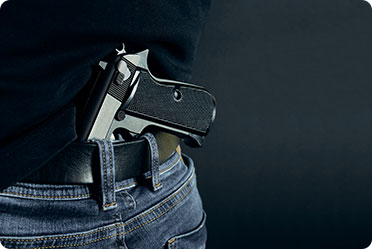
A friend of mine named “Jim” was recently harassed and arrested when a hotel owner became alarmed after seeing the butt of a gun sticking out of the front of his waistband. Jim explained that he had recently moved to Idaho, and learned from the local Sheriff’s Office that he did not need a permit to carry a gun in public, as long as it was not concealed. So, while walking to and from a bar from his hotel room, he put his defensive handgun inside the waistband of his blue jeans, with the butt sticking out in front of his shirt and, in his mind, “clearly visible”.
I am often asked what concealed means under the criminal law. Keep in mind that what constitutes concealed carry is a product of state law. Each state has its own definition by statute and the court’s interpretation of that state’s statute (case law).
Idaho Code §18-3302 is violated when a person does not have a permit to carry a concealed weapon, but does so within city limits and without meeting any of the statutory exceptions. The Idaho Supreme Court has held that whether a firearm is concealed depends on whether it is carried and not “discernible by ordinary observation”. See State v. McNary, 100 Idaho 244, 247, 596 P.2d 417, 420 (1979).
In another Idaho Supreme Court case, State v. Button, 37 P.3d 23, 136 Idaho 526 (2001), the Court upheld Mr. Button’s conviction for concealed carry when his handgun was wedged between the front seats of his car. The arresting officer testified that when she approached Mr. Button’s car, she looked inside for weapons or contraband through the driver’s side window and did not see a gun, even though the window was rolled down. However, when she walked to the passenger’s side (where Mr. Button was seated), she could see 2” of the butt of the gun sticking out from between the seats.
The Court upheld Mr. Button’s conviction for carrying a concealed weapon without a permit, because Idaho Code §18-3302(9) prevents any unlicensed person from carrying a concealed weapon and using the element of surprise to harm others. The Court decided that because the officer could not see the firearm from the driver’s side, and that the officer could only see a small portion of the weapon from one particular vantage point, the weapon was not “discernible from ordinary observation”.
Jim in my example could be out of luck based on the court’s definition in the Button case. A prosecutor arguing Jim’s case may very well win the argument that he violated I.C. §18-3302(9) because Jim’s handgun, a small portion of which was only visible when looking at him from the front, revealed only a small portion from one particular vantage point.
The lesson is that if you are not going to get a concealed carry permit, it is best to prominently display your firearm to avoid an arrest and potential conviction. The less the gun is visible, the more likely it is that the Court will find that it was not “discernible from ordinary observation”.

Call Now At
(208) 203-7876 (Meridian)
(208) 328-5795 (Emmett)